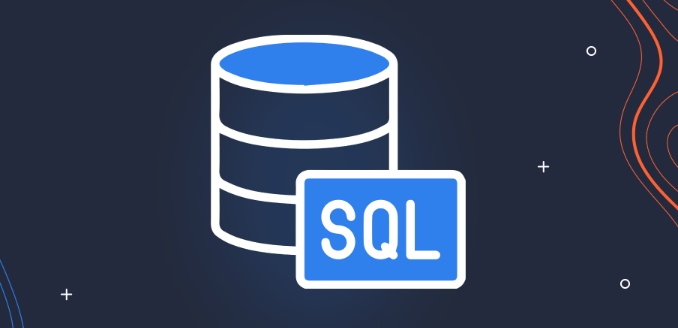SQL can still deal with big data, and the key is to combine the correct methods and tools. 1. Use SQL on Hadoop tools such as Hive, Impala, Presto, and Spark SQL to enable efficient queries on petabytes of data. 2. Combine the data lake and the data warehouse, and use ETL tools to connect the original data and structured analysis. 3. Master query optimization skills, including partitioning, indexing, field selection, small table broadcasting and parallelism adjustment. 4. Combining real-time processing technologies, such as Flink SQL and Spark Streaming, meet real-time response needs.

As the amount of data is getting bigger and bigger, can SQL still cope? The answer is yes, but the premise is that you have to use the right method. Although SQL itself is powerful, it is no longer enough to rely on traditional databases when facing big data. The core of integrating SQL and big data technology is to select the right tools, streamline the process, and optimize query.

1. Make good use of SQL on Hadoop tools
Many of the mainstream big data platforms now support SQL-like query methods, such as Hive, Impala, Presto, and Spark SQL. They allow you to still use familiar SQL syntax when processing petabytes of data.
- Hive is the first solution to emerge, suitable for offline analysis, but has high latency.
- Impala is more suitable for real-time queries, fast response, and suitable for interactive analysis.
- Spark SQL combines in-memory computing and DataFrame interfaces to suit ETL and complex logic.
- Presto is suitable for cross-data source queries, such as checking HDFS and MySQL at the same time.
When using this type of tool, it is also important to pay attention to the selection of data formats. Parquet and ORC column storage formats can significantly improve query performance.

2. The combination of data lakes and data warehouses
Nowadays, many companies are building data lakes to store raw data on HDFS or S3. But having a data lake alone is not enough. You also need a data warehouse with a clear structure to support reporting and BI analysis. SQL comes in handy at this time.
- The data lake is responsible for the storage and preliminary cleaning of raw data.
- The data warehouse is responsible for structured processing and is used by SQL queries.
- The middle can be connected by ETL tools (such as Airflow Spark).
For example, you can use Spark SQL to clean, convert the JSON files in the data lake, write them to the Hive table, and then connect and query by BI tools.

3. Query optimization techniques must not be missing
Even if you use the big data platform, slow SQL query is still a common problem. At this time, optimization is particularly critical.
Several practical tips:
- Reasonable partitioning: Partition by time, region and other fields to reduce the amount of scanned data.
- Using indexes: Although big data platforms do not all support traditional indexes, indexes like HBase, Iceberg, and Delta Lake can be built.
- Avoid SELECT *: Take only the required fields, especially in columnar storage, which is particularly important.
- Small table broadcast: When joining, if there is a small table on one side, you can broadcast it to reduce the Shuffle.
- Adjust the parallelism: reasonably set the parallelism of tasks based on cluster resources to avoid resource waste or bottlenecks.
4. Used in conjunction with real-time processing
Traditional SQL is more suitable for batch processing, but now more and more scenarios require real-time response. At this time, you can combine Kafka, Flink, Spark Streaming and other tools.
for example:
- Kafka collects real-time logs.
- Flink uses SQL for real-time aggregation.
- The result is written to ClickHouse, HBase, or Redis for real-time Kanban use.
Both Flink SQL and Spark Structured Streaming support SQL-like syntax, which is low-cost in learning and is suitable for transitioning from batch to streaming.
Basically that's it. The key to integrating SQL and big data is not to abandon SQL, but to find its positioning in the new architecture, and then use appropriate tools and methods to make it well.
The above is the detailed content of SQL and Big Data Integration Strategies. For more information, please follow other related articles on the PHP Chinese website!

Hot AI Tools

Undress AI Tool
Undress images for free

Undresser.AI Undress
AI-powered app for creating realistic nude photos

AI Clothes Remover
Online AI tool for removing clothes from photos.

Clothoff.io
AI clothes remover

Video Face Swap
Swap faces in any video effortlessly with our completely free AI face swap tool!

Hot Article

Hot Tools

Notepad++7.3.1
Easy-to-use and free code editor

SublimeText3 Chinese version
Chinese version, very easy to use

Zend Studio 13.0.1
Powerful PHP integrated development environment

Dreamweaver CS6
Visual web development tools

SublimeText3 Mac version
God-level code editing software (SublimeText3)
 Defining Database Schemas with SQL CREATE TABLE Statements
Jul 05, 2025 am 01:55 AM
Defining Database Schemas with SQL CREATE TABLE Statements
Jul 05, 2025 am 01:55 AM
In database design, use the CREATETABLE statement to define table structures and constraints to ensure data integrity. 1. Each table needs to specify the field, data type and primary key, such as user_idINTPRIMARYKEY; 2. Add NOTNULL, UNIQUE, DEFAULT and other constraints to improve data consistency, such as emailVARCHAR(255)NOTNULLUNIQUE; 3. Use FOREIGNKEY to establish the relationship between tables, such as orders table references the primary key of the users table through user_id.
 Key Differences Between SQL Functions and Stored Procedures.
Jul 05, 2025 am 01:38 AM
Key Differences Between SQL Functions and Stored Procedures.
Jul 05, 2025 am 01:38 AM
SQLfunctionsandstoredproceduresdifferinpurpose,returnbehavior,callingcontext,andsecurity.1.Functionsreturnasinglevalueortableandareusedforcomputationswithinqueries,whileproceduresperformcomplexoperationsanddatamodifications.2.Functionsmustreturnavalu
 Using SQL LAG and LEAD functions for time-series analysis.
Jul 05, 2025 am 01:34 AM
Using SQL LAG and LEAD functions for time-series analysis.
Jul 05, 2025 am 01:34 AM
LAG and LEAD in SQL are window functions used to compare the current row with the previous row data. 1. LAG (column, offset, default) is used to obtain the data of the offset line before the current line. The default value is 1. If there is no previous line, the default is returned; 2. LEAD (column, offset, default) is used to obtain the subsequent line. They are often used in time series analysis, such as calculating sales changes, user behavior intervals, etc. For example, obtain the sales of the previous day through LAG (sales, 1, 0) and calculate the difference and growth rate; obtain the next visit time through LEAD (visit_date) and calculate the number of days between them in combination with DATEDIFF;
 Can You Provide Code Examples Demonstrating Pattern Matching in SQL?
Jul 04, 2025 am 02:51 AM
Can You Provide Code Examples Demonstrating Pattern Matching in SQL?
Jul 04, 2025 am 02:51 AM
Pattern matching functions in SQL include LIKE operator and REGEXP regular expression matching. 1. The LIKE operator uses wildcards '%' and '_' to perform pattern matching at basic and specific locations. 2.REGEXP is used for more complex string matching, such as the extraction of email formats and log error messages. Pattern matching is very useful in data analysis and processing, but attention should be paid to query performance issues.
 How to find columns with a specific name in a SQL database?
Jul 07, 2025 am 02:08 AM
How to find columns with a specific name in a SQL database?
Jul 07, 2025 am 02:08 AM
To find columns with specific names in SQL databases, it can be achieved through system information schema or the database comes with its own metadata table. 1. Use INFORMATION_SCHEMA.COLUMNS query is suitable for most SQL databases, such as MySQL, PostgreSQL and SQLServer, and matches through SELECTTABLE_NAME, COLUMN_NAME and combined with WHERECOLUMN_NAMELIKE or =; 2. Specific databases can query system tables or views, such as SQLServer uses sys.columns to combine sys.tables for JOIN query, PostgreSQL can be used through inf
 How to create a user and grant permissions in SQL
Jul 05, 2025 am 01:51 AM
How to create a user and grant permissions in SQL
Jul 05, 2025 am 01:51 AM
Create a user using the CREATEUSER command, for example, MySQL: CREATEUSER'new_user'@'host'IDENTIFIEDBY'password'; PostgreSQL: CREATEUSERnew_userWITHPASSWORD'password'; 2. Grant permission to use the GRANT command, such as GRANTSELECTONdatabase_name.TO'new_user'@'host'; 3. Revoke permission to use the REVOKE command, such as REVOKEDELETEONdatabase_name.FROM'new_user
 What is the SQL LIKE Operator and How Do I Use It Effectively?
Jul 05, 2025 am 01:18 AM
What is the SQL LIKE Operator and How Do I Use It Effectively?
Jul 05, 2025 am 01:18 AM
TheSQLLIKEoperatorisusedforpatternmatchinginSQLqueries,allowingsearchesforspecifiedpatternsincolumns.Ituseswildcardslike'%'forzeroormorecharactersand'_'forasinglecharacter.Here'showtouseiteffectively:1)UseLIKEwithwildcardstofindpatterns,e.g.,'J%'forn
 How to backup and restore a SQL database
Jul 06, 2025 am 01:04 AM
How to backup and restore a SQL database
Jul 06, 2025 am 01:04 AM
Backing up and restoring SQL databases is a key operation to prevent data loss and system failure. 1. Use SSMS to visually back up the database, select complete and differential backup types and set a secure path; 2. Use T-SQL commands to achieve flexible backups, supporting automation and remote execution; 3. Recovering the database can be completed through SSMS or RESTOREDATABASE commands, and use WITHREPLACE and SINGLE_USER modes if necessary; 4. Pay attention to permission configuration, path access, avoid overwriting the production environment and verifying backup integrity. Mastering these methods can effectively ensure data security and business continuity.






